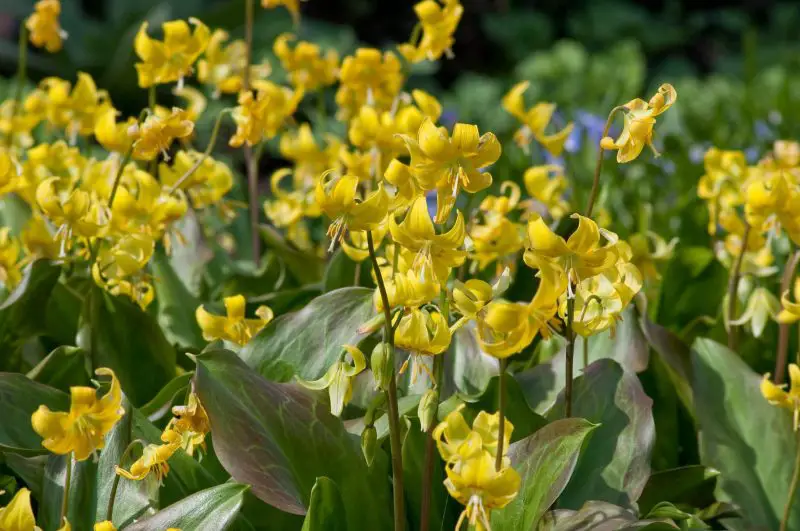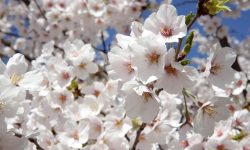Trout Lily is a delicate, early-spring perennial known for its charming yellow flowers and mottled foliage that resembles a trout’s skin. Native to woodland areas, this plant adds a touch of natural elegance to shaded gardens, rockeries, and forested landscapes. Its subtle beauty, combined with ease of care, makes it a favorite among gardeners seeking low-maintenance yet visually striking plants.
Caring for Trout Lily requires understanding its unique needs, including proper soil, water, light, and seasonal maintenance. By providing the right environment, monitoring growth, and practicing attentive care, gardeners can enjoy a reliable bloom each spring. In addition to aesthetic value, Trout Lily supports early-season pollinators, enhancing local biodiversity. With simple yet thoughtful care strategies, this perennial thrives and continues to enrich gardens year after year.
Understanding Trout Lily

Trout Lily is a woodland native that prefers shaded or partially shaded areas with moist, well-drained soil. Its leaves emerge in early spring before many other plants, offering early greenery, followed by delicate, nodding yellow flowers. The mottled leaves not only resemble trout skin but also help the plant blend naturally into woodland settings. Understanding its growth pattern is key to successful cultivation.
The plant propagates primarily through bulbs, which develop slowly and may take several years to reach flowering size. Trout Lily grows in clumps, gradually expanding to form naturalized patches in shaded garden beds. Recognizing its dormancy period in late spring and summer allows gardeners to avoid disturbing bulbs during critical growth stages. By studying its life cycle, gardeners can provide optimal care and maintain consistent flowering over time.
Trout Lily thrives best in organic-rich soil that retains moisture but drains well. Adding leaf litter or compost mimics its natural woodland habitat. By recreating these conditions, gardeners encourage vigorous growth, healthy foliage, and robust flower production, ensuring the plant remains a reliable and attractive part of the garden’s early-season display.
Soil Preparation for Healthy Growth
Healthy soil is the foundation for Trout Lily cultivation. The plant prefers moist, loamy soil rich in organic matter. Before planting, it is essential to loosen the soil to a depth of 6–8 inches, removing stones and debris to promote root penetration. Adding compost or leaf mold improves fertility, soil texture, and water retention. Well-prepared soil ensures strong roots, vigorous foliage, and more prolific flowering.
Understanding the soil’s pH is also important. Trout Lily favors slightly acidic to neutral soil conditions, which supports nutrient uptake and overall plant health. Avoid heavy clay soils that retain excess water, as they can cause bulb rot and fungal problems. Amending with sand or organic matter enhances drainage and reduces the risk of disease.
After preparing the soil, create gentle planting beds that maintain moisture without waterlogging. Mulching with organic material further stabilizes soil temperature and conserves moisture. Thoughtful soil preparation ensures Trout Lily establishes well, providing early spring blooms that remain vibrant, healthy, and sustainable year after year.
Watering Needs Throughout the Season
Trout Lily thrives in consistently moist soil, particularly during its active growth and flowering period in early spring. Maintaining even moisture supports the development of healthy foliage and abundant blooms. Newly planted bulbs require gentle, regular watering to help roots establish firmly in the soil. Gardeners should monitor soil conditions carefully, ensuring the substrate is damp but not soggy, as excess water can lead to root rot and fungal diseases, which may compromise plant health and flowering potential.
As Trout Lily becomes established, it demonstrates moderate drought tolerance, but supplemental watering during dry spells remains important for optimal growth. Mulching around the base of the plants helps retain soil moisture, reduces evaporation, and stabilizes soil temperature. Watering early in the morning is ideal, allowing foliage to dry quickly and minimizing the risk of fungal infections. This approach maintains plant vigor and ensures strong stems, healthy leaves, and long-lasting flowers throughout the bloom period.
Seasonal adjustments are necessary to match the plant’s natural growth cycle. In late spring and early summer, when Trout Lily enters dormancy, water requirements decrease significantly. Overwatering during dormancy can cause bulb rot and weaken the plant for the following year. By observing weather patterns, rainfall, and soil moisture, gardeners can adjust watering schedules accordingly. Providing the right amount of water throughout the season ensures Trout Lily continues to thrive, producing beautiful early-spring flowers and healthy foliage that enhance shaded and woodland garden areas.
Fertilizing Trout Lily
Proper fertilization is essential to support the growth, flowering, and long-term health of Trout Lily. While this perennial is not highly demanding, providing nutrients at key stages encourages robust foliage and vibrant blooms. Applying a balanced, slow-release fertilizer in early spring, just as new leaves and flower buds emerge, helps supply essential nutrients for root development and above-ground growth. A balanced formula with equal parts nitrogen, phosphorus, and potassium ensures healthy leaf production, strong stems, and prolific flowering without overstimulating foliage at the expense of blooms.
For established plants, supplemental feeding during the growing season can enhance flower size and duration. Light applications of compost, well-rotted manure, or organic fertilizers between emerging leaves and flowering spikes provide a steady nutrient supply without causing burn or excessive vegetative growth. Avoid high-nitrogen fertilizers, as they may promote leafy growth rather than blooms, resulting in fewer flowers and reduced visual appeal. Foliar feeding with diluted liquid fertilizer can offer a quick nutrient boost, especially for plants showing early signs of deficiency, such as pale or yellowing leaves.
After flowering, it is important to reduce or stop fertilization as the plant enters dormancy. Excess nutrients during dormancy can encourage weak, unnecessary growth and increase susceptibility to disease. Incorporating organic matter around the base of the plants in late spring or early summer helps replenish soil nutrients naturally and supports the next year’s growth. By following proper fertilization techniques, gardeners ensure that Trout Lily remains healthy, produces optimal blooms, and thrives in shaded garden beds, rockeries, or naturalized woodland areas for many seasons.
Seasonal Care Guide for Trout Lily
Early Spring Care
Early spring is the most important stage for Trout Lily growth. As leaves and flower buds begin to emerge, maintaining evenly moist soil is crucial for healthy development. Gardeners should gently clear fallen debris from the previous season to reduce the risk of fungal infections and allow sunlight to reach the young shoots. Light mulching with leaf litter or compost helps regulate soil temperature, conserve moisture, and protect delicate sprouts from sudden frost.
Fertilization during this period supports root and leaf growth while preparing the plant for optimal flowering. Using a slow-release, balanced fertilizer encourages strong stems and abundant blooms without promoting excessive foliage. Early monitoring for pests such as slugs or snails, which often feed on tender leaves, is essential. Addressing problems promptly ensures the plant remains vigorous, setting a strong foundation for successful flowering throughout the season. Proper early spring care maximizes bloom potential and overall plant health.
Mid-Spring Bloom Maintenance
During mid-spring, Trout Lily reaches its peak flowering stage, requiring careful maintenance to prolong blooms. Consistent watering supports flowers and foliage, but soil should not be waterlogged to prevent root diseases. Deadheading spent blooms helps conserve plant energy and can prevent self-seeding, particularly in garden beds where control of spread is desired. Avoid disturbing bulbs while performing maintenance, as their roots are still delicate during active growth.
Maintaining garden hygiene is vital during this stage. Remove weeds that compete for nutrients and light, and monitor for signs of fungal infections or insect damage. Light watering in the morning ensures leaves dry quickly, reducing disease risk. By carefully tending the plants during mid-spring, gardeners enhance bloom longevity, maintain healthy foliage, and support the overall vigor of Trout Lily. Regular observation ensures that any issues are addressed quickly, keeping the plant at its peak throughout the flowering season.
Late Spring Transition
As the flowering period ends, Trout Lily enters its natural dormancy phase. Leaf yellowing signals the plant is redirecting energy to underground bulbs. During this transition, reduce watering to avoid excessive moisture, which can lead to bulb rot. Fertilization is not needed, as active growth has slowed significantly. Observing this natural shift is key to ensuring the plant stores energy effectively for the next season.
This is an ideal time to tidy the area, remove spent foliage, and lightly mulch to protect bulbs through the summer months. Avoid heavy soil disturbance, as the bulbs remain vulnerable while storing nutrients. By respecting this late spring transition, gardeners help Trout Lily survive dormancy, ensuring vigorous growth and abundant blooms in the following spring. Careful attention during this period maintains the long-term health and stability of the plants.
Summer Dormancy Care
During summer dormancy, Trout Lily enters a rest period where minimal intervention is required. Bulbs store energy underground, and overwatering or fertilization at this stage can cause rot or weaken the plant. Maintaining a dry, well-drained environment ensures bulbs remain healthy until the next growth cycle. Gardeners should avoid disturbing the soil or bulbs while performing other maintenance tasks nearby.
Light mulching helps moderate soil temperature and retain small amounts of moisture without waterlogging. This dormancy phase is critical for energy conservation, preparing the plant for early spring emergence. By respecting the plant’s natural cycle, gardeners ensure that Trout Lily re-emerges strong, producing healthy foliage and vibrant flowers. Proper summer care is essential to maintain consistent seasonal flowering and the overall longevity of the plant.
Common Pests and Diseases
Common Pests
Trout Lily is generally resilient, but certain pests can occasionally affect its growth and flowering. Slugs and snails are among the most common threats, particularly during early spring when new leaves and shoots are tender. These pests feed on foliage, leaving holes that can reduce the plant’s photosynthetic capacity and overall vigor. Monitoring plants regularly for damage and early signs of pest presence is essential to prevent widespread issues.
Gardeners can control slugs and snails through physical barriers, handpicking, or using environmentally friendly slug baits. Encouraging natural predators such as birds and ground beetles also helps maintain a balanced ecosystem. Maintaining garden hygiene by removing debris and fallen leaves reduces hiding spots for pests. By taking proactive measures, Trout Lily can thrive with minimal damage, ensuring robust foliage and vibrant blooms throughout the growing season.
Common Diseases
While Trout Lily is relatively disease-resistant, it can be susceptible to fungal issues in overly wet or poorly drained soils. Leaf spot, powdery mildew, and root rot are potential problems when moisture levels are excessive or airflow is restricted. These diseases can lead to yellowing leaves, stunted growth, and reduced flowering, affecting the plant’s overall health and aesthetic appeal.
Preventive care is crucial. Planting Trout Lily in well-drained soil and providing adequate spacing promotes airflow and reduces humidity around foliage. Watering early in the day allows leaves to dry quickly, minimizing fungal growth. Removing and disposing of infected plant material promptly prevents the spread of pathogens. By following these precautions, gardeners can maintain healthy Trout Lily plants, ensuring consistent blooms and vigorous growth while minimizing disease risk.
Propagation Methods for Trout Lily
Trout Lily can be propagated effectively through bulbs, which is the most reliable method for maintaining plant characteristics. Mature bulbs produce offsets that can be separated and replanted to expand existing patches. This method ensures that the new plants retain the same flower color, leaf pattern, and growth habit as the parent. Propagation by bulbs is typically performed in late summer or early fall, after the plant has entered dormancy and the foliage has naturally died back.
Seed propagation is another option, though it requires patience and careful attention. Seeds should be sown in well-prepared, moist soil and lightly covered with compost or leaf mold. Germination can be slow, often taking a full growing season or longer before seedlings develop into mature, flowering plants. Cold stratification, which simulates winter conditions, can improve germination rates by breaking seed dormancy. Regular watering and protection from slugs and other pests are essential during the seedling stage.
Dividing clumps is also an effective method for propagation, particularly in older colonies. Gently lift established clumps after the growing season and separate individual bulbs or small clusters. Replant them immediately in suitable soil, ensuring proper spacing to avoid overcrowding and promote airflow. By following these propagation techniques, gardeners can expand their Trout Lily displays, maintain healthy plants, and enjoy a vibrant spring bloom for years to come.
Mistakes to Avoid and How to Solve
Overwatering and Poor Drainage
One of the most common mistakes in Trout Lily care is providing excessive water or planting in poorly drained soil. While the plant enjoys moist conditions, too much water can lead to root rot, fungal infections, and weakened bulbs. Gardeners sometimes misinterpret yellowing or drooping leaves as a sign of drought, prompting them to water even more, which exacerbates the problem and reduces flowering potential. Standing water around the bulbs can seriously damage roots and affect the plant’s long-term health.
The solution is careful monitoring and soil management. Check soil moisture before watering and only water when the top inch of soil feels dry. Planting Trout Lily in raised beds or amending heavy clay soil with sand or organic matter improves drainage. Applying a light layer of mulch helps retain necessary moisture while preventing waterlogging. By balancing water correctly, gardeners encourage stronger roots, lush foliage, and more prolific blooms. This approach ensures the plant thrives naturally in shaded, woodland-inspired garden beds.
Neglecting Spread Control
Trout Lily naturally forms clumps and can self-seed if left unattended. While this trait is beneficial for naturalized areas, it may become problematic in formal garden layouts. Uncontrolled spreading can crowd neighboring plants, reduce airflow, and interfere with the aesthetic design of beds. Gardeners often underestimate the plant’s ability to expand rapidly, which can lead to an overgrown and untidy appearance.
Proactive management is essential to maintain balance. Thin clumps regularly to preserve spacing and airflow, and remove seedlings that sprout in unwanted areas. Deadhead flowers if self-seeding is not desired, allowing energy to focus on bulb development rather than uncontrolled reproduction. Understanding Trout Lily’s growth habits helps gardeners harness its beauty while preventing it from dominating the garden. Controlled spread supports both a visually appealing layout and the plant’s overall health.
Improper Pruning and Maintenance
Failing to prune or remove spent flowers and damaged leaves can negatively impact Trout Lily. Leaving old foliage increases the risk of disease and pest infestations. Neglecting deadheading may cause the plant to divert energy into seed production instead of further flowering. Harsh pruning at the wrong time can stress the plant, reduce blooms, and weaken overall vigor, making it more susceptible to environmental stressors.
To correct this, adopt consistent, gentle pruning practices. Remove faded flowers promptly to encourage continued blooms and cut back damaged or yellowing leaves after flowering. At the end of the season, trim foliage down to the ground to support dormancy and bulb health. Regular maintenance ensures Trout Lily maintains a tidy appearance, produces abundant flowers, and remains vigorous year after year. Combined with proper watering and soil care, this approach maximizes the plant’s beauty and longevity.
Pruning and Deadheading Techniques
Pruning and deadheading are essential practices to maintain the health and beauty of Trout Lily. While the plant has a natural, woodland appearance, removing spent flowers prevents energy from being diverted to seed production. This simple step prolongs the bloom period, encourages more vibrant flowers, and keeps the garden looking tidy. It also reduces the likelihood of self-seeding in areas where controlled growth is desired.
Deadheading should be performed carefully, using clean hands or small scissors to remove faded flowers without damaging nearby leaves or bulbs. While pruning is minimal during active growth, it is beneficial to trim away yellowing or damaged foliage after flowering ends. This allows the plant to conserve energy and focus on underground bulb development. Maintaining a regular schedule ensures Trout Lily remains visually appealing and produces consistent blooms each spring.
At the end of the season, more extensive pruning may be necessary. Cutting back the foliage to ground level supports dormancy and protects bulbs through summer. Proper pruning combined with correct watering and soil care ensures Trout Lily stays healthy, vigorous, and capable of producing optimal flowering in the following season. By understanding and applying these techniques, gardeners can maximize the plant’s ornamental value and longevity in any garden setting.
Habitat and Naturalizing Tips
Trout Lily thrives in shaded or partially shaded environments, often found naturally in woodland areas with rich, loamy soil. Replicating these conditions in your garden is key to healthy growth and abundant flowering. Soil should be well-drained yet consistently moist, enriched with organic matter such as compost or leaf litter to mimic the natural forest floor. These conditions support strong root systems and encourage the development of vibrant, early-spring flowers.
Naturalizing Trout Lily involves planting bulbs or offsets in groups to create informal drifts that look spontaneous yet harmonious. When placing plants, consider spacing carefully to allow for natural clumping while preventing overcrowding. Light management is crucial: filtered sunlight or dappled shade works best, as too much direct sunlight can scorch leaves and reduce bloom quality. Incorporating mulch helps maintain soil moisture, regulate temperature, and provide protection for bulbs during seasonal fluctuations.
Additionally, naturalized planting enhances the ecological value of your garden. Trout Lily attracts early pollinators such as bees and supports woodland biodiversity. Combining it with other native spring ephemerals, ferns, or groundcovers creates a visually appealing, multi-layered landscape that changes dynamically through the seasons. Observing its growth habits and seasonal patterns allows gardeners to establish sustainable, low-maintenance plantings that flourish year after year. By understanding and mimicking its native habitat, Trout Lily can thrive beautifully in both woodland-inspired and shaded garden settings.
Companion Planting with Trout Lily
Companion planting enhances the beauty and health of Trout Lily while creating a balanced garden ecosystem. Plants that share similar growing conditions—partial to full shade, moist, well-drained soil—are ideal companions. Woodland perennials, ferns, and spring ephemerals like bloodroot or wild ginger provide complementary foliage and staggered blooms, enhancing visual interest throughout the season.
Companion planting also supports ecological health. Pollinator-friendly companions attract bees, butterflies, and other beneficial insects, promoting cross-pollination and overall biodiversity. Additionally, groundcovers like hostas or mosses help retain soil moisture and reduce weed growth, providing a natural mulch effect for Trout Lily bulbs. Strategic pairing prevents overcrowding, ensuring proper airflow and minimizing fungal disease risks.
When planning companions, consider bloom timing and plant height to highlight Trout Lily’s delicate yellow flowers. Lower-growing companions can frame the plant while taller perennials add depth and texture. Thoughtful companion planting not only emphasizes Trout Lily’s ornamental qualities but also fosters a healthier, more resilient garden environment. By combining aesthetic and ecological benefits, gardeners create a visually stunning and naturally thriving woodland-inspired landscape.
FAQ About Trout Lily Care
What is the best sunlight condition for Trout Lily?
Trout Lily thrives in partial to full shade, mimicking its natural woodland habitat. Morning sun with afternoon shade is ideal. Too much direct sunlight can scorch leaves and reduce flowering. Providing the right light ensures healthy foliage, robust stems, and vibrant early-spring blooms, while supporting long-term plant health.
How often should I water Trout Lily?
Trout Lily requires consistently moist soil, especially during active growth in early spring. Water when the top inch of soil feels dry, avoiding waterlogging. During summer dormancy, reduce watering significantly to prevent bulb rot. Proper watering ensures vigorous growth, prolonged flowering, and long-term survival of the plant.
Can Trout Lily spread in my garden?
Yes, Trout Lily naturally forms clumps and can self-seed if left unchecked. In naturalized areas, this is desirable, but in formal garden beds, it may require thinning. Deadheading flowers or dividing clumps every few years helps control spread while maintaining healthy, attractive patches of blooms.
When should I fertilize Trout Lily?
Fertilize in early spring as leaves and flower buds emerge. A balanced, slow-release fertilizer supports root growth, strong stems, and abundant flowers. Avoid fertilizing during dormancy, as excess nutrients can weaken bulbs. Light compost applications also provide natural nourishment for sustained plant health.
What are common pests and diseases affecting Trout Lily?
Slugs and snails may feed on tender leaves, while fungal diseases like leaf spot or root rot can occur in overly wet or poorly drained soil. Preventive measures include well-drained soil, proper spacing, mulching, and removing infected material. Early intervention keeps Trout Lily healthy and ensures consistent flowering.
Conclusion
Trout Lily is a captivating woodland perennial that brings delicate beauty to any shaded garden. By understanding its growth habits, providing proper watering, fertilization, and seasonal care, gardeners can enjoy vibrant blooms year after year. Pruning, deadheading, and companion planting enhance both aesthetics and plant health, while careful management prevents common mistakes and pest issues. Whether naturalizing a woodland area or adding charm to a garden bed, attentive care ensures Trout Lily thrives. Following these expert tips guarantees lasting beauty, resilient growth, and a flourishing display of early-spring flowers for many seasons.






